Letters from Lodi
An insightful and objective look at viticulture and winemaking from the Lodi
Appellation and the growers and vintners behind these crafts. Told from the
perspective of multi-award winning wine journalist, Randy Caparoso.
A year of blogs on Lodi's winegrowing history
.jpg)
Lodi Grape Festival Court, circa 1940s
Unlike Hollywood stars, viticultural and winemaking regions are never overnight sensations. For European regions, great wines and success stories are the accumulation of centuries, if not millenniums, of practical knowledge, hard won through trial and error. New World wine regions have had the advantage of learning from the Old, and so their histories are more compressed.
Over the past year on this blog site we’ve devoted a considerable amount of words and images to the history of the Lodi Viticultural Area precisely because of the region’s seemingly overnight success. As recently summarized in How Lodi saved the wine world in 2015, Lodi has been recognized by various groups as special enough to garner titles like “Wine Region of the Year,” “Vineyard of the Year,” “Grower of the Year,” “Winery of the Year,” and “Sustainable Winegrower of the Year.”
The more success is achieved, the more everyone wonders where it came from.
It wasn’t out of nowhere. As a matter of fact, it took over 160 years for Lodi to evolve from a supplier of grapes for fresh markets and home winemakers across the country to a producer of the sweet fortified wines and affordable jug wines consumed for decades by the vast majority of Americans. Then most recently, as the nation’s largest and most versatile grower of the classic wine grapes (i.e. Vitis vinifera) utilized by today’s premium wine producers, from tiny to huge.
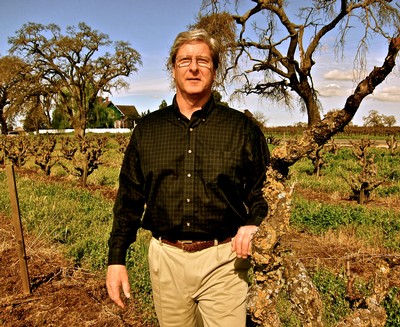
Mark Chandler among Lodi old vines (2011)
In 1991 nearly 500 of Lodi’s growers came together to form the Lodi-Woodbridge Winegrape Commission (now the Lodi Winegrape Commission) to take stronger control of their own economic growth. In 2011 the organization’s departing Executive Director Mark Chandler (today, Mayor of the City of Lodi) was quoted to say, “When I began work with the Commission in 1991 there were 8 wineries in the area... that number has grown to 85 wineries, and I expect more than 100 wineries will be established in the near future.”
On his Chandler & Company Wine Consultancy site, Mr. Chandler elucidates that Lodi now has more than 100,000 acres planted, yielding an annual average of 600,000 tons of grapes with a value exceeding $300 million – comprising some 20% of California’s entire wine grape production, more than Napa and Sonoma counties combined.
, greeting somms.jpg)
Lodi Winegrape Commission's Camron King greets top sommeliers visiting from across the country this past September 2015 (photo courtesy of John Curley Photography)
Yet because Lodi's reputation as a producer of premium wine is still relatively new, current Lodi Winegrape Commission Executive Director Camron King spends a great deal of his time traveling around the world explaining how the region has built on its "heritage," as well as "innovation and commitment to place and people through our leadership in sustainability." Entering its eleventh year of successful implementation in 2016, Lodi Rules for Sustainable Winegrowing has become the blueprint for all other sustainable viticultural programs across the country.
Blessed by a mild and consistent variation of Mediterranean climate and classic, porous topographies, Lodi has attained a position of critical and economic strength. But if history teaches anything, it’s that success is precarious. Especially one entailing wine – which, after all, is essentially an agricultural product, prone to ebbs and flows of Nature as much as marketplace and economy.
Yet a “man who swims against the stream,” Woodrow Wilson once said, “knows the strength of it.” Knowing how we got here can only make us better. Hence, this past year’s flurry of in-depth posts focused on various aspects of the history of winegrowing in Lodi:
.jpg)
Lodi’s fascinating history as a Johnny-come-lately wine region
Since 1991 the Lodi Winegrape Commission has diligently worked to fulfill one of its original mandates: raising awareness of the intrinsic quality of Lodi Viticultural Area grown wine grapes, now evidenced by the ascendant quality of Lodi wines.
But the evidence hasn't always been readily apparent. Significant wines with Lodi on the label did not even appear on the market until the mid-1990s; a good 10 to 30 years after other West Coast wine regions – from Washington’s Columbia Valley all the way down to Santa Barbara – were established as sources of premium quality grapes and wines.
So the question is: why, for a region known for plantings of wine grapes since the 1860s, did it take Lodi so long to make its move? Let’s discuss.
The reasons can be boiled down to essentially two historical factors:
1. The wine production industry in Lodi has been dominated by grower organized and operated cooperatives during most of the past 115 years.
2. These co-op wineries were focused primarily on the types of wines that dominated the domestic wine market during the decades following Prohibition (ending in 1933) up until the early 1970s – primarily sweet, fortified “dessert” wines.
Lodi, in other words, found itself behind the eight ball by the mid-1960s when producers of more classic, European style tables wines such as Robert Mondavi were first proclaiming a “Golden Age of California Wine.” Read more
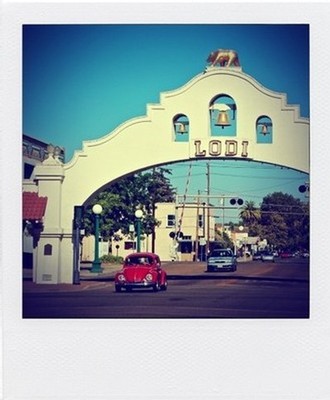
1969 – A year of change and unforgettable times
1969. If you weren’t born yet, we envy your youth, but feel sorry you missed it.
There were good times in 1969. There was a little thing called Woodstock, which everyone and their friends’ friends claimed to have “almost” attended. Neil Armstrong set foot on the moon. Sports fans had their “Miracle Mets” and “Broadway Joe” Namath. Star Trek was just cancelled, which only got Trekkies warmed up...
1969 was also the year that the song “Lodi” – composed by John Fogerty and performed by Creedence Clearwater Revival – came out on the B-side of “Bad Moon Rising,” and later on their Green River album. For a song with such a sweet, memorable opening chord progression, “Lodi” sure has a downer of a chorus: Oh lord, I’m stuck in Lodi again...
1969, as posted earlier this month (see Lodi’s Johnny-come-lately history), was also the year when the wine industry reported sales of dry table wines exceeding sweet, fortified dessert wines for the first time since pre-Prohibition days. The Lodi wine region’s 15 or so wineries, unfortunately, were more equipped for the production of dessert wines, bulk wines or brandies. Read more

1907 Tokay Carnival "Queen Zinfandel" Bertha De Almado
In 1907 Lodi celebrated grapes like no American city never-ever has
Lodi enjoys a glorious, oft-times phenomenal, past. This especially goes for what occurred 108 years ago; a time when things were looking really, really good for this burgeoning table and wine grape region.
According to the Lodi Historical Society’s Lodi Historian newsletter (Fall 1990), in 1907...
The grape had replaced the watermelon. The town had just become incorporated (in 1906). Tracks for a new passenger railroad were being laid between Stockton and the 2,000 inhabitants of this proud city. It was spring and the disastrous flood of 1907 had receded...
Charles Ray (a local businessman) put forth the idea of advertising the beauty and value of the Tokay grape by having a large carnival which would make the entire central portion of the state, if not the world, sit up and take notice...
Thus, in the spring of 1907 Lodi citizens swiftly mobilized to put on what was to be a first, historical Tokay Carnival. The celebration was to last three days – September 19 through 21. Read more
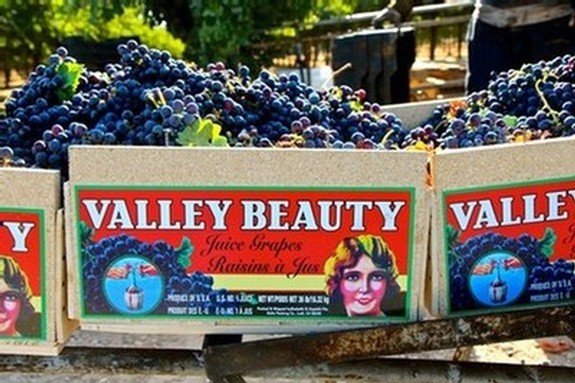
2014 harvest of field-packed Lodi Cabernet Sauvignon
Colorful lug labels tell the history of Lodi’s grape packing industry
Robert Mondavi’s family found their earliest fortunes as Lodi grape packers, not as winemakers. Mondavi’s father, Cesare Mondavi, emigrated from Central Italy’s Marche region (between Umbria and the Adriatic Sea) to Minnesota, and then brought his family to the Lodi area during the early 1920s, at a time when Prohibition was dramatically boosting sales of fresh-packed grapes to markets across the nation.
Like other fruit packing companies, Cesare Mondavi’s C. Mondavi & Sons was successful particularly because of one provision in the Volstead Act (outlawing the sale and transportation of “intoxicating liquors”) allowing the head of every household to produce up to 200 gallons of fermented beverages per year for personal consumption.
Overnight, countless Americans from the Atlantic to the Pacific became home winemakers, causing fresh grape sales to soar. Numerous California wineries closed down during Prohibition (ending in 1933), but Lodi growers scrambled to plant more vines to keep up with the demand. Read more
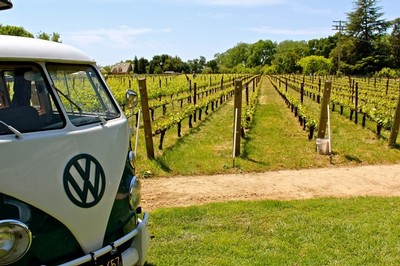
Bokisch Ranches Las Cerezas Vineyard on east side of Mokelumne River AVA
The Mokelumne River Viticultural Area (Part 1)
Boundaries, heart and soul
The Mokelumne River AVA (American Viticultural Area) is one of the seven sub-appellations located within the larger Lodi AVA established in August 2006 by the TTB (the U.S. Department of the Treasury’s Tax and Trade Bureau).
The AVA is named after the Mokelumne River, which drains out of the Sierra Nevada Mountains into the San Joaquin River, meandering through the northern portion of the established appellation, with connecting creeks, sloughs, a canal and aqueduct running through its interior.
To qualify as an AVA, every region must demonstrate historic reasons justifying its boundaries and identity. “Mokelumne” is derived from the language of the Plains Miwok. According to Ralph A. Clark (Lodi – Images of America), mokul is a corruption of the Miwok word for river, and umne means “people of.” A Spanish missionary named Narciso Durán referred to the river area as Muquelumnes in an 1817 document; and around 1844, the American explorer John C. Frémont is credited with the modern spelling of the name Mokelumne (also the original name of the City of Lodi until 1874)...
As with all wines, the growing prestige of Mokelumne River AVA grown wines are based on the classic wine concept of terroir – that is, the growing conditions that have a direct, tangible impact on wine quality and characteristics. Read more
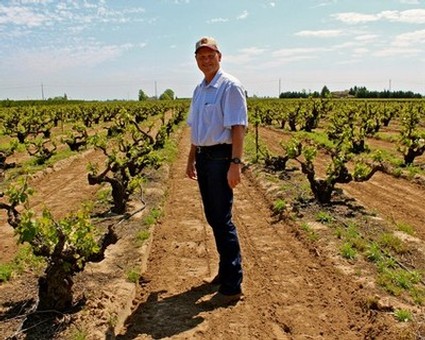
Craig Rous in his ancient Zinfandel vineyard (planted in 1909)
The Mokelumne River Viticultural Area (part 2) – winemakers talk dirty
From sandy loams to loamy sands
When Lodi winemakers extol the qualities of Mokelumne River AVA grown grapes and wines, almost universally they talk mostly about soil. It is topography and soil that distinguishes Mokelumne River from the six other sub-appellations of Lodi, and it is the variations of a single soil type – from sandy loams to loamy sands – that distinguish some parts of Mokelumne River from other parts of Mokelumne River.
In the original 2005 petition submitted to the TTB for seven new American Viticultural Areas within the Lodi AVA, it is explained: “Sandy loam Tokay and Acampo soils dominate the proposed Mokelumne River viticultural area. The soils are young, deep, and drain well… Also, the soils tend to be granular and crumbly, of a fine texture and without gravel… with low moisture holding capacity.”
In fact, few AVAs are defined by as much of a consistency of topography (50 to 150-ft. elevation flats, with less than 2% slopes) and singular sandy alluvium as the Mokelumne River AVA. Whereas most American wine regions consist of a multiplicity of soils, slopes and elevations, in the Mokelumne River AVA there are no steep mountains or significant hills, no boulders, rocks or even gravel: just this well drained mix of decomposed granite (i.e. DG, derived from the base rock of the Sierra Nevadas, eroded away by constant river action) and sediment washed down from the mountains, starting in the Miocene period (some 20 million years ago), when the San Joaquin Valley was still part of a huge inland sea. Read more
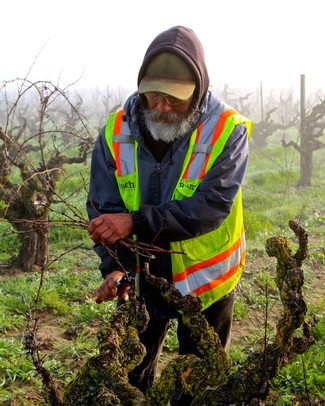
Winter pruning of 100-year-old vines in Krischenmann Vineyard
The Mokelumne River Viticultural Area (part 3) – grapes, ungrafted vines, rags to riches
Transition from Table Grape to Premium Varietal Wine Production
About 40% of California's entire annual Zinfandel production is grown in the Lodi AVA; almost all of that, in the 42,000 acres of planted vines comprising the Lodi sub-region of Mokelumne River AVA. While Zinfandel is considered Mokelumne River's heritage wine grape – cultivated in the region since the late 1850s – it is by no means the only variety of Vitis vinifera flourishing in this appellation. Black skinned varieties such as Petite Sirah, Carignan, Grenache, Barbera and Alicante Bouschet have been cultivated within the boundaries of the Mokelumne River AVA since the nineteenth century, and are still in great demand from giant production to boutique sized wineries, operating outside and inside the Lodi AVA.
At the beginning of the modern wine era in the 1960s, white wine grapes such as Chenin Blanc and Colombard were widely planted in the Mokelumne River AVA to meet the needs of a sudden "white wine boom." Colombard was originally brought into San Joaquin Valley and planted by George West, founder of El Pinal Winery (est. 1858 in Stockton), and the grape was called “West’s White Prolific.” Zinfandel and Carignan remained the major black skinned grapes for red wine production; even during the 1970s, when the domestic wine market began to transition from generic "jug" and sweet dessert wines to premium varietal wines.
However, even up until the 1980s, the Mokelumne River region's predominant Vitis vinifera was actually Flame Tokay, grown in the region for the table grape market (as well as for fortified dessert wine production) since the 1850s. As Flame Tokay began to be phased out in the fresh markets in favor of hybridized Flame Seedless grapes better suited to Southern Joaquin Valley (between Madera and Kern Counties), thousands of Mokelumne River acres devoted to Flame Tokay were replanted or grafted over to wine grapes needed to meet the growing demand for premium varietal wine grapes such as Cabernet Sauvignon, Chardonnay, Sauvignon Blanc, Merlot, Syrah, Viognier, Pinot Noir, as well as increased plantings of Zinfandel (including its clonal variant, Primitivo) and Petite Sirah. Read more
.jpg)
Mural depicting early 1900s grape packer in shed prohibiting smoking and talking